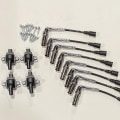The Triumph TR series has been part of automotive history for over a century, with its origins dating back to the early 1900s. An iconic British marque, the Triumph TR series has been a defining part of the motor industry since its inception. From its classic styling to its performance-oriented engineering, the Triumph TR series is a legend amongst motor enthusiasts. This article will provide a brief overview of the Triumph TR series, exploring its origins and development over the years. We'll look at some of the most significant models in the series, as well as some of their defining features. The Triumph TR series has been part of automotive history for over a century, with its origins dating back to the early 1900s. An iconic British marque, the Triumph TR series has been a defining part of the motor industry since its inception. From its classic styling to its performance-oriented engineering, the Triumph TR series is a legend amongst motor enthusiasts. This article will provide a brief overview of the Triumph TR series, exploring its origins and development over the years. We'll look at some of the most significant models in the series, as well as some of their defining features.
We'll also take a look at how the Triumph TR series has evolved since it first hit the roads. So, if you're looking for an introduction to the world of Triumph TRs, then this article is for you! The Triumph TR series is an iconic British car line that has been in production since the 1950s. Developed by the Standard-Triumph Motor Company, the Triumph TR series has had a long and varied history, and it continues to be an influential part of the automotive world today. The first model in the series was the TR2, which was released in 1953. This two-seater roadster was powered by a 2-litre engine and featured a sleek, aerodynamic design. It was immediately popular with drivers who appreciated its combination of power, agility, and style.
The TR2 was later followed by the TR3 in 1957, which featured a number of improvements including increased power and an upgraded suspension.
The TR4
, released in 1961, featured a more powerful 2.5-litre engine and a more muscular body style that included larger bumpers and squared-off wheel arches. It was also one of the first cars to feature disc brakes on all four wheels. The TR4 proved to be one of the most successful models in the series and was followed by the TR5 in 1967. This model featured a 3-litre engine and an improved suspension system.The TR6, released in 1969, featured a new 2.5-litre engine and a redesigned body style that included wider fenders and a more modern grille. The TR6 continued to be popular with drivers who appreciated its combination of performance and style. The last model in the series was the TR7, which was released in 1975 and featured a more angular body style with integrated bumpers and wraparound headlights. It also featured a new 2.0-litre engine and an improved suspension system.
Throughout its history, the Triumph TR series has had a significant impact on the automotive world. Its combination of power, agility, and style has made it a popular choice for drivers who want an exciting driving experience. Despite its long history, the Triumph TR series continues to be an influential part of the automotive world today.
The Triumph TR6 (1969)
The Triumph TR6 was released in 1969 as part of the Triumph TR series. It featured a new 2.5-litre engine and a redesigned body style that included wider fenders and a more modern grille.This was the first of the TR series to be powered by an inline 6-cylinder engine, which provided greater power and performance than the previous TR models. The TR6 also had improved brakes and suspension for better handling and a more comfortable ride. The car was available in both coupe and convertible form, with a variety of optional extras.
The Triumph TR4 (1961)
The Triumph TR4 was first introduced in 1961 and was the successor of the TR3. This car featured a more powerful 2.5-litre engine and a more muscular body style that included larger bumpers and squared-off wheel arches. It also had an improved suspension system with wider track, as well as a new transmission option, the option to switch between overdrive and non-overdrive.The TR4 was the first Triumph model to feature disc brakes. The TR4 was met with great success, becoming the best-selling sports car of its time in the UK. The car's popularity also spread to other parts of the world, with many people in North America, Africa and Australia embracing the iconic design. The TR4 was available in various body styles, including a convertible, a coupe and a station wagon.
It was powered by an inline four-cylinder engine that produced 105 horsepower. The engine was mated to either a four-speed manual transmission or an optional three-speed automatic transmission.
The Triumph TR2 (1953)
The Triumph TR2 was the first model in the series, introduced in 1953. This two-seater roadster was powered by a 2-litre engine and featured a sleek, aerodynamic design. With its lightweight construction and low centre of gravity, the TR2 was an instant hit among performance enthusiasts. The TR2 also had great handling capabilities thanks to its independent front suspension, rack and pinion steering, and four-wheel disc brakes. The TR2 was a great success, with more than 25,000 units produced over its four-year production run.The Triumph TR7 (1975)
The Triumph TR7 was first introduced in 1975, and it represented a major change in the design of the TR series.This model featured a more angular body style with integrated bumpers and wraparound headlights. The TR7 also saw the introduction of the now-famous wedge shape, a design which has become synonymous with the Triumph brand. The TR7 was available as either a two-door or four-door car, and it had several engine options. The two-door models had either a 1.6L or 2.0L engine, while the four-door models had either a 1.7L or 2.0L engine. All models of the TR7 came with a five-speed manual transmission, although an optional three-speed automatic transmission was available. The TR7 was praised for its fuel efficiency and handling, and it is still considered to be one of the most reliable British cars ever made.
Despite its success, production of the TR7 ceased in 1981, and it was replaced by the more popular TR8.
The Triumph TR5 (1967)
The Triumph TR5 was introduced in 1967 and featured a 3-litre engine and an improved suspension system. This model was the first to be fitted with the Lucas fuel injection system, which allowed for greater power and performance than its predecessors. It had a top speed of 125 mph and could reach 0-60 mph in 8.5 seconds. The interior was also improved, with leather trim and a modern dashboard. The TR5 was also considered to be a more comfortable ride than previous models, thanks to its improved suspension system.This car was the first to have an independent rear suspension, allowing for better handling and greater stability in the corners. The TR5 also featured upgraded brakes, further enhancing its performance.
The Triumph TR3 (1957)
The Triumph TR3 was first released in 1957 and marked the beginning of the third generation of the Triumph TR series. The TR3 featured a number of improvements over its predecessor, including increased power and an upgraded suspension. The engine was a 2.0-litre straight-four with twin carburettors, producing 95bhp and offering a top speed of nearly 100mph.The suspension was an independent coil-spring set up with telescopic dampers, offering improved handling. Inside the cabin, the TR3 featured leather-trimmed bucket seats, rubber floor mats, and a full array of gauges. The Triumph TR3 was a popular model and it was produced until 1961 when it was replaced by the TR4. It was also the first model in the TR series to be exported to the US, where it became a popular sports car. The TR3 is now seen as an iconic classic car and continues to be popular with collectors and enthusiasts. The Triumph TR series has had a long and varied history, but its combination of power, agility, and style have made it one of the most iconic British car lines ever produced.
The original TR2 was introduced in 1953 and subsequent models such as the TR3, TR4, TR5, TR6, and TR7 have all been successful in their own right. Despite the passage of time, the Triumph TR series continues to be an influential part of the automotive world today.


